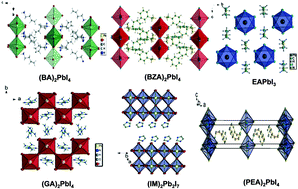Exploration of two-dimensional perovskites incorporating methylammonium for high performance solar cells†
Abstract
We investigated the structural and optical properties of various 2-dimensional (2D) perovskites by incorporating them into a 3-dimensional (3D) perovskite (CH3NH3PbI3, CH3NH3 = MA) to address the disadvantages of the existing 3D perovskite. When the 2D perovskites ((BA)2PbI4, (BZA)2PbI4, EAPbI3, (GA)2PbI4, (IM)2Pb2I7 and (PEA)2PbI4 (butylammonium (BA), benzylammonium (BZA), ethylammonium (EA), guanidium (GA), imidazolium (IM) and phenethylammonium (PEA)) were incorporated into the 3D perovskite (MAPbI3), the optical and electrical properties were changed. In particular, the GA2PbI4 mixed with MAI perovskite showed a significantly decreased optical band gap compared to the other mixed perovskites. Remarkable photoluminescence emissions in (IM)2(MA)Pb2I7 and (GA)(MA)PbI4 perovskites were observed compared to their 2D perovskites. Compared to those of the pure 2D perovskites, the longer average carrier lifetimes obtained for the mixed perovskites suggest that the incorporation of the 3D perovskite into the 2D perovskite induced an increase of the efficiency of charge transfer. The optical constants (n and k) of the mixed perovskites are found to significantly increase compared with those of the 2D perovskites. It can be attributed to the larger oscillator strength of excitons in the mixed perovskite than that for the 2D perovskite.

- This article is part of the themed collection: Crystal Engineering Techniques


 Please wait while we load your content...
Please wait while we load your content...